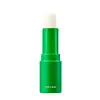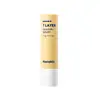What's inside
What's inside
 Key Ingredients
Key Ingredients

 Benefits
Benefits

 Concerns
Concerns

 Ingredients Side-by-side
Ingredients Side-by-side

Helianthus Annuus Seed Oil
EmollientRicinus Communis Seed Oil
MaskingHydrogenated Castor Oil Dimer Dilinoleate
Skin ConditioningMacadamia Integrifolia Seed Oil
Skin ConditioningHelianthus Annuus Seed Wax
Skin ConditioningBis-Behenyl/Isostearyl/Phytosteryl Dimer Dilinoleyl Dimer Dilinoleate
EmollientButyrospermum Parkii Butter
Skin ConditioningPhytosteryl/Isostearyl/Cetyl/Stearyl/Behenyl Dimer Dilinoleate
Skin ConditioningPrunus Amygdalus Dulcis Oil
Skin ConditioningSimmondsia Chinensis Seed Oil
EmollientEuphorbia Cerifera Wax
Phytosteryl/Behenyl/Octyldodecyl Lauroyl Glutamate
Skin ConditioningPyrus Malus Seed Oil
EmollientTribehenin
EmollientTrilaurin
Skin ConditioningCamellia Japonica Seed Oil
EmollientBrassica Campestris Seed Oil
Skin ConditioningCentella Asiatica Extract
CleansingChamaecyparis Obtusa Water
MaskingSodium Hyaluronate
HumectantAvena Sativa Kernel Extract
AbrasiveAnthemis Nobilis Flower Extract
MaskingHydrolyzed Hyaluronic Acid
HumectantRosmarinus Officinalis Leaf Extract
AntimicrobialPortulaca Oleracea Extract
Skin ConditioningHyaluronic Acid
HumectantAcetylated Sucrose Distearate
EmollientC10-18 Triglycerides
EmollientTocopherol
AntioxidantWater
Skin ConditioningPropanediol
Solvent1,2-Hexanediol
Skin ConditioningSodium Hyaluronate Crosspolymer
HumectantHydrolyzed Glycosaminoglycans
HumectantButylene Glycol
HumectantGlycerin
HumectantBenzyl Glycol
SolventEthylhexylglycerin
Skin ConditioningHelianthus Annuus Seed Oil, Ricinus Communis Seed Oil, Hydrogenated Castor Oil Dimer Dilinoleate, Macadamia Integrifolia Seed Oil, Helianthus Annuus Seed Wax, Bis-Behenyl/Isostearyl/Phytosteryl Dimer Dilinoleyl Dimer Dilinoleate, Butyrospermum Parkii Butter, Phytosteryl/Isostearyl/Cetyl/Stearyl/Behenyl Dimer Dilinoleate, Prunus Amygdalus Dulcis Oil, Simmondsia Chinensis Seed Oil, Euphorbia Cerifera Wax, Phytosteryl/Behenyl/Octyldodecyl Lauroyl Glutamate, Pyrus Malus Seed Oil, Tribehenin, Trilaurin, Camellia Japonica Seed Oil, Brassica Campestris Seed Oil, Centella Asiatica Extract, Chamaecyparis Obtusa Water, Sodium Hyaluronate, Avena Sativa Kernel Extract, Anthemis Nobilis Flower Extract, Hydrolyzed Hyaluronic Acid, Rosmarinus Officinalis Leaf Extract, Portulaca Oleracea Extract, Hyaluronic Acid, Acetylated Sucrose Distearate, C10-18 Triglycerides, Tocopherol, Water, Propanediol, 1,2-Hexanediol, Sodium Hyaluronate Crosspolymer, Hydrolyzed Glycosaminoglycans, Butylene Glycol, Glycerin, Benzyl Glycol, Ethylhexylglycerin
Helianthus Annuus Seed Oil
EmollientOctyldodecanol
EmollientRicinus Communis Seed Oil
MaskingHydrogenated Castor Oil Dimer Dilinoleate
Skin ConditioningPhytosteryl/Isostearyl/Cetyl/Stearyl/Behenyl Dimer Dilinoleate
Skin ConditioningSimmondsia Chinensis Seed Oil
EmollientHelianthus Annuus Seed Wax
Skin ConditioningBis-Behenyl/Isostearyl/Phytosteryl Dimer Dilinoleyl Dimer Dilinoleate
EmollientHydrogenated Vegetable Oil
EmollientEuphorbia Cerifera Wax
Olea Europaea Fruit Oil
MaskingPyrus Malus Seed Oil
EmollientCamellia Japonica Seed Oil
EmollientTribehenin
EmollientAcetylated Sucrose Distearate
EmollientParfum
MaskingGlycerin
HumectantPanthenol
Skin ConditioningWater
Skin ConditioningCaprylic/Capric Triglyceride
MaskingHydrogenated Lecithin
EmulsifyingCetearyl Alcohol
EmollientPropanediol
SolventStearic Acid
CleansingMelia Azadirachta Flower Extract
Skin ConditioningOcimum Sanctum Leaf Extract
Skin ConditioningMelia Azadirachta Leaf Extract
Skin Conditioning1,2-Hexanediol
Skin ConditioningBetaine
HumectantCurcuma Longa Root Extract
MaskingCorallina Officinalis Extract
Skin ConditioningCitrus Unshiu Peel Extract
MaskingHydrolyzed Collagen
EmollientCeramide NP
Skin ConditioningBehenyl Alcohol
EmollientCholesterol
EmollientPhytosphingosine
Skin ConditioningCeramide Ng
Skin ConditioningCeramide Ns
Skin ConditioningHydrolyzed Elastin
EmollientCeramide AP
Skin ConditioningCeramide As
Skin ConditioningSodium Hyaluronate
HumectantSqualane
EmollientCeramide EOP
Skin ConditioningMethylpropanediol
SolventFructooligosaccharides
HumectantHydroxypropyl Bispalmitamide Mea
EmollientEthylhexylglycerin
Skin ConditioningHelianthus Annuus Seed Oil, Octyldodecanol, Ricinus Communis Seed Oil, Hydrogenated Castor Oil Dimer Dilinoleate, Phytosteryl/Isostearyl/Cetyl/Stearyl/Behenyl Dimer Dilinoleate, Simmondsia Chinensis Seed Oil, Helianthus Annuus Seed Wax, Bis-Behenyl/Isostearyl/Phytosteryl Dimer Dilinoleyl Dimer Dilinoleate, Hydrogenated Vegetable Oil, Euphorbia Cerifera Wax, Olea Europaea Fruit Oil, Pyrus Malus Seed Oil, Camellia Japonica Seed Oil, Tribehenin, Acetylated Sucrose Distearate, Parfum, Glycerin, Panthenol, Water, Caprylic/Capric Triglyceride, Hydrogenated Lecithin, Cetearyl Alcohol, Propanediol, Stearic Acid, Melia Azadirachta Flower Extract, Ocimum Sanctum Leaf Extract, Melia Azadirachta Leaf Extract, 1,2-Hexanediol, Betaine, Curcuma Longa Root Extract, Corallina Officinalis Extract, Citrus Unshiu Peel Extract, Hydrolyzed Collagen, Ceramide NP, Behenyl Alcohol, Cholesterol, Phytosphingosine, Ceramide Ng, Ceramide Ns, Hydrolyzed Elastin, Ceramide AP, Ceramide As, Sodium Hyaluronate, Squalane, Ceramide EOP, Methylpropanediol, Fructooligosaccharides, Hydroxypropyl Bispalmitamide Mea, Ethylhexylglycerin
Ingredients Explained
These ingredients are found in both products.
Ingredients higher up in an ingredient list are typically present in a larger amount.
1,2-Hexanediol is a synthetic liquid and another multi-functional powerhouse.
It is a:
- Humectant, drawing moisture into the skin
- Emollient, helping to soften skin
- Solvent, dispersing and stabilizing formulas
- Preservative booster, enhancing the antimicrobial activity of other preservatives
We don't have a description for Acetylated Sucrose Distearate yet.
We don't have a description for Bis-Behenyl/Isostearyl/Phytosteryl Dimer Dilinoleyl Dimer Dilinoleate yet.
Camellia Japonica Seed Oil comes from the Japanese Camellia plant. This plant is native to East Asia and known as "Tsubaki" in Japanese.
Camellia Japonica Seed Oil is rich in oleic acid. This makes it a great emollient. Emollients help soften and soothe the skin by forming a barrier. This barrier traps moisture within, keeping your skin hydated.
Ethylhexylglycerin (we can't pronounce this either) is commonly used as a preservative and skin softener. It is derived from glyceryl.
You might see Ethylhexylglycerin often paired with other preservatives such as phenoxyethanol. Ethylhexylglycerin has been found to increase the effectiveness of these other preservatives.
Glycerin is already naturally found in your skin. It helps moisturize and protect your skin.
A study from 2016 found glycerin to be more effective as a humectant than AHAs and hyaluronic acid.
As a humectant, it helps the skin stay hydrated by pulling moisture to your skin. The low molecular weight of glycerin allows it to pull moisture into the deeper layers of your skin.
Hydrated skin improves your skin barrier; Your skin barrier helps protect against irritants and bacteria.
Glycerin has also been found to have antimicrobial and antiviral properties. Due to these properties, glycerin is often used in wound and burn treatments.
In cosmetics, glycerin is usually derived from plants such as soybean or palm. However, it can also be sourced from animals, such as tallow or animal fat.
This ingredient is organic, colorless, odorless, and non-toxic.
Glycerin is the name for this ingredient in American English. British English uses Glycerol/Glycerine.
Learn more about GlycerinHelianthus Annuus Seed Oil is the oil derived from the seeds of a Sunflower. Sunflower seed oil is non-fragrant. It is an emollient, meaning it helps to soften the skin.
Sunflower seed oil contains many fatty acids. The fatty acids found in sunflower seeds include (from highest amount to least): linoleic acid, myristic acid, palmitic acid, stearic acid, arachidic acid, oleic acid, and linolenic acid.
These fatty acids help the skin create ceramides. Ceramides play a role in repairing the skin barrier.
Helianthus Annuus Seed Oil helps moisturize the skin. This in turn helps the skin look more rejuvenated and smoother.
Sunflowers are rich in vitamin E.
Historians believe Indigenous cultures of North America domesticated sunflowers before corn. Thus they relied on sunflower oil for a variety of uses. One such use is moisturizing skin and hair.
Sunflower seed oil may not be fungal acne safe. We recommend speaking with a professional if you have any concerns.
Learn more about Helianthus Annuus Seed OilHelianthus Annuus Seed Wax is created from the common sunflower.
Sunflower seed wax is made up of long chain non-glyceride esters, a small amount of fatty alcohols, and fatty acids.
This ingredient is often used to enhance the texture of products. The fatty acid properties also help hydrate the skin.
Learn more about Helianthus Annuus Seed WaxHydrogenated Castor Oil Dimer Dilinoleate is an oil and isn't fungal acne safe.
We don't have a description for Phytosteryl/Isostearyl/Cetyl/Stearyl/Behenyl Dimer Dilinoleate yet.
Propanediol is an all-star ingredient. It softens, hydrates, and smooths the skin.
It’s often used to:
Propanediol is not likely to cause sensitivity and considered safe to use. It is derived from corn or petroleum with a clear color and no scent.
Learn more about PropanediolPyrus Malus Seed Oil is an oil.
Ricinus Communis Seed Oil is the INCI name for castor oil.
Castor Oil helps moisturize the skin. It is rich in a fatty acid called ricinoleic acid. This fatty acid helps prevent moisture loss on the skin. This helps keep your skin soft and hydrated. Ricinoleic acid also has anti-inflammatory and pain reducing properties.
Besides hydrating the skin, castor oil is also used to hydrate hair. By keeping the hair shaft moisturized, breakage is decreased. More studies are needed to show castor oil's effective on stimulating hair growth.
Castor oil is created by cold-pressing castor seeds and then purifying the oil with heat. It was used in Ancient Egypt as fuel in lamps and to help treat eye irritation.
The term 'fragrance' is not regulated in many countries. In many cases, it is up to the brand to define this term. For instance, many brands choose to label themselves as "fragrance-free" because they are not using synthetic fragrances. However, their products may still contain ingredients such as essential oils that are considered a fragrance.
Learn more about Ricinus Communis Seed OilThis oil comes from the seeds of the desert shrub called Jojoba. It is more commonly known as jojoba oil, a non-comedogenic oil.
Jojoba oil does not contain fragrance and has many fatty-acids, making it a great soothing ingredient.
It also contains Vitamin E, a great moisturizing ingredient. Vitamin E is also an antioxidant and protects your skin against oxidative damage.
This ingredient humectant properties, meaning it helps draw moisture from the air. This helps keep your skin hydrated.
While jojoba has antibacterial properties, it is only able to kill some strains of bacteria.
Studies also show it helps in wound healing. In fact, Indigenous cultures have used jojoba as a moisturizer and to help treat burns for centuries.
Fun fact: Jojoba oil similar to natural human skin sebum, so it has a great effect on dry skin. It is also promising with helping to regulate sebum production.
Due to its fatty acid content, Jojoba oil may not be fungal acne safe. We recommend speaking with a professional if you have any concerns.
Learn more about Simmondsia Chinensis Seed OilSodium Hyaluronate is hyaluronic acid's salt form. It is commonly derived from the sodium salt of hyaluronic acid.
Like hyaluronic acid, it is great at holding water and acts as a humectant. This makes it a great skin hydrating ingredient.
Sodium Hyaluronate is naturally occurring in our bodies and is mostly found in eye fluid and joints.
These are some other common types of Hyaluronic Acid:
Learn more about Sodium HyaluronateTribehenin comes from glycerin and behenic acid.
It is used as an emollient, or moisturizer. Emollients form a thin barrier on skin to prevent moisture from escaping.
This ingredient may not be Malassezia folliculitis, or fungal-acne safe.
Learn more about TribeheninWater. It's the most common cosmetic ingredient of all. You'll usually see it at the top of ingredient lists, meaning that it makes up the largest part of the product.
So why is it so popular? Water most often acts as a solvent - this means that it helps dissolve other ingredients into the formulation.
You'll also recognize water as that liquid we all need to stay alive. If you see this, drink a glass of water. Stay hydrated!
Learn more about WaterEuphorbia Cerifera wax comes from a shrub in Northern Mexico. It is used to stabilize formulations and has emollient properties.
Emollients form a thin layer on top of skin to prevent water from evaporating, keeping skin and lips hydrated.
According to a manufacturer, this wax can range from a yellow/brown color to translucent.
Learn more about Euphorbia Cerifera Wax